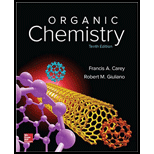
ORGANIC CHEMISTRY (LL)-W/SOLN.>CUSTOM<
10th Edition
ISBN: 9781259972348
Author: Carey
Publisher: MCG CUSTOM
expand_more
expand_more
format_list_bulleted
Question
Chapter 6, Problem 34P
Interpretation Introduction
Interpretation:
The structures of compounds A and B including stereochemistry in the given sequence of reactions are to be determined.
Concept Introduction:
The nucleophile approaches the carbon atom attached to the halogen from the back side, and hence inversion of configuration takes place.
The stereochemistry at any other carbon atoms remains unchanged since the reaction does not take place at those carbon atoms.
Reaction of alcohols with a tosyl group does not change the stereochemistry at the carbon atom attached to the hydroxyl group.
Expert Solution & Answer
Want to see the full answer?
Check out a sample textbook solution
Students have asked these similar questions
What is the product of the reaction?
F3C.
CF3
OMe
NaOH / H₂O
What is the product of the reaction?
F3C.
CF3
OMe
NaOH / H₂O
What would you expect to be the major product obtained from the following reaction? Please explain what is happening here. Provide a detailed explanation and a drawing showing how the reaction occurs. The correct answer to this question is V.
Chapter 6 Solutions
ORGANIC CHEMISTRY (LL)-W/SOLN.>CUSTOM<
Ch. 6.1 - Prob. 1PCh. 6.2 - 1-Bromo-3-chloropropane reacts with one molar...Ch. 6.3 - Prob. 3PCh. 6.3 - The Fischer projection for (+)-2-bromooctane is...Ch. 6.3 - Would you expect the 2-octanol formed by SN2...Ch. 6.3 - Prob. 6PCh. 6.4 - Prob. 7PCh. 6.4 - The first step in the synthesis of the...Ch. 6.6 - Prob. 9PCh. 6.6 - Prob. 10P
Ch. 6.7 - Prob. 11PCh. 6.8 - Prob. 12PCh. 6.9 - Diethyl ether (CH3CH2OCH2CH3) has a dielectric...Ch. 6.9 - Unlike protic solvent which solvate from complexes...Ch. 6.10 - Prob. 15PCh. 6.10 - Prob. 16PCh. 6.10 - The hydrolysis of sulfonate of 2-octanol is...Ch. 6.11 - Prob. 18PCh. 6 - Prob. 19PCh. 6 - Prob. 20PCh. 6 - Both of the following reactions involve...Ch. 6 - Prob. 22PCh. 6 - Prob. 23PCh. 6 - Sodium nitrite (NaNO2) reacted with 2-iodooctane...Ch. 6 - Prob. 25PCh. 6 - Prob. 26PCh. 6 - Prob. 27PCh. 6 - The reaction of 2,2-dimethyl-1-propanol with HBr...Ch. 6 - If the temperature is not kept below 25oC during...Ch. 6 - The reaction of cyclopentyl bromide with sodium...Ch. 6 - Prob. 31PCh. 6 - Prob. 32PCh. 6 - Write an equation, clearly showing the...Ch. 6 - Prob. 34PCh. 6 - Based on what we know about nucleophiles and...Ch. 6 - Prob. 36PCh. 6 - Prob. 37PCh. 6 - Prob. 38PCh. 6 - Prob. 39PCh. 6 - Prob. 40PCh. 6 - Prob. 41DSPCh. 6 - Prob. 42DSPCh. 6 - Prob. 43DSPCh. 6 - Prob. 44DSPCh. 6 - Prob. 45DSPCh. 6 - Prob. 46DSP
Knowledge Booster
Similar questions
- Please answer the question for the reactions, thank youarrow_forwardWhat is the product of the following reaction? Please include a detailed explanation of what is happening in this question. Include a drawing showing how the reagent is reacting with the catalyst to produce the correct product. The correct answer is IV.arrow_forwardPlease complete the reactions, thank youarrow_forward
- Consider the synthesis. What is compound Y? Please explain what is happening in this question. Provide a detailed explanation and a drawing to show how the compound Y creates the product. The correct answer is D.arrow_forwardWhat would be the major product of the following reaction? Please include a detailed explanation of what is happening in this question. Include steps and a drawing to show this reaction proceeds and how the final product is formed. The correct answer is B. I put answer D and I don't really understand what is going on in the question.arrow_forwardWhat is the product of the following reaction? Please explain what is happening in this question. Provide a detailed explanation and a drawing showing how the reagent is reacting with the catalysts to product the correct product. The correct answer is B.arrow_forward
- What is the missing intermediate 1 and the final product 2. Please include a detailed explanation explaining the steps of malonic ester synthesis. Please include drawings of the intermediate and how it occurs and how the final product is former.arrow_forwardWhat would be the reagents and conditions above and below the arrow that will complete the proposed acetoacetic ester synthesis? If it cannot be done efficiently, then I will choose that answer. There could be 2 or 4 reagents involved. Please provide a detailed explanation and drawings showing how it would proceed with the correct reagents.arrow_forwardFor benzene, the ∆H° of vaporization is 30.72 kJ/mol and the ∆S° of vaporization is 86.97 J/mol・K. At 1.00 atm and 228.0 K, what is the ∆G° of vaporization for benzene, in kJ/mol?arrow_forward
- The reaction Q(g) + R(g) → Z(l) is shown to be exothermic. Which of the following is true concerning the reaction. it is spontaneous only at High T, it is spontaneous at low T it is nonspontaneous at all T it is spontanrous at all T. it is non spontaneous only at low T.arrow_forwardThe reaction Q(g) + R(g) → Z(l) is shown to be exothermic. Which of the following is true concerning the reactionarrow_forwardWhich of the following has the largest standard molar entropy, S° (298.15 K) He H2 NaCl KBr Hgarrow_forward
arrow_back_ios
SEE MORE QUESTIONS
arrow_forward_ios
Recommended textbooks for you
 Organic ChemistryChemistryISBN:9781305580350Author:William H. Brown, Brent L. Iverson, Eric Anslyn, Christopher S. FootePublisher:Cengage Learning
Organic ChemistryChemistryISBN:9781305580350Author:William H. Brown, Brent L. Iverson, Eric Anslyn, Christopher S. FootePublisher:Cengage Learning

Organic Chemistry
Chemistry
ISBN:9781305580350
Author:William H. Brown, Brent L. Iverson, Eric Anslyn, Christopher S. Foote
Publisher:Cengage Learning
